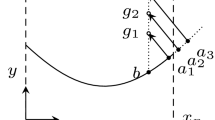Abstract
Solid wall boundary conditions have been an area of active research within the context of Smoothed Particle Hydrodynamics (SPH) for quite a while. Ferrand et al. (Int. J. Numer. Methods Fluids 71(4), 446–472, 2012) presented a novel approach using a renormalization factor in the SPH approximation. The computation of this factor depends on an integral along the boundary of the domain and in their original paper Ferrand et al. gave an analytical formulation for the 2-D case using the Wendland kernel. In this paper the formulation will be extended to 3-D, again providing analytical formulae. Due to the boundary being two dimensional a domain decomposition algorithm needs to be employed in order to obtain special integration domains. For these the analytical formulae will be presented when using the Wendland kernel. The algorithm presented within this paper is applied to several academic test-cases for which either analytical results or simulations with other methods are available. It will be shown that the present formulation produces accurate results and provides a significant improvement compared to approximative methods.
Similar content being viewed by others
References
Amicarelli, A., Agate, G., Guandalini, R.: Development and validation of a SPH model using discrete surface elements at boundaries. In: Proceedings of the 7th International SPHERIC Workshop, pp. 369–374. Prato (2012)
Crespo, A.C., Dominguez, J.M., Barreiro, A., Gómez-Gesteira, M., Rogers, B.D.: GPUs, a new tool of acceleration in CFD: efficiency and reliability on smoothed particle hydrodynamics methods. PLoS ONE 6(6), e20,685 (2011). doi:10.1371/journal.pone.0020685
Dalrymple, R.A., Knio, O.: SPH modelling of water waves. In: H. Hanson, M. Larson (eds.) ASCE Conference Proceedings, vol. 260, p. 80. 20Lund, Sweden (2001). doi:10.1061/40566(260)80. http://link.aip.org/link/?ASC/260/80/1
Ferrand, M., Laurence, D., Rogers, B.D., Violeau, D., Kassiotis, C.: Unified semi-analytical wall boundary conditions for inviscid, laminar or turbulent flows in the meshless SPH method. Int. J. Numer. Methods Fluids 71(4), 446–472 (2012). doi:10.1002/fld.3666
Gingold, R.A., Monaghan, J.J.: Smoothed particle hydrodynamics - theory and application to non-spherical stars. Mon. Not. R. Astron. Soc. 181, 375–389 (1977). http://adsabs.harvard.edu/abs/1977MNRAS.181..375G
Kleefsman, K., Fekken, G., Veldman, A., Iwanowski, B., Buchner, B.: A volume-of-fluid based simulation method for wave impact problems. J. Comput. Phys. 206(1), 363–393 (2005). doi:10.1016/j.jcp.2004.12.007. http://www.sciencedirect.com/science/article/pii/S0021999104005170
Libersky, L.D., Petschek, A.G., Carney, T.C., Hipp, J.R., Allahdadi, F.A.: High strain lagrangian hydrodynamics: a three-dimensional SPH code for dynamic material response. J. Comput. Phys. 109(1), 67–75 (1993). doi:10.1006/jcph.1993.1199. http://www.sciencedirect.com/science/article/pii/S002199918371199X
Lucy, L.B.: A numerical approach to the testing of the fission hypothesis. Astron. J. 82, 1013–1024 (1977). http://adsabs.harvard.edu/abs/1977AJ.....82.1013L
Mayrhofer, A., Rogers, B.D., Violeau, D., Ferrand, M.: Investigation of wall bounded flows using SPH and the unified semi-analytical wall boundary conditions. Comput. Phys. Commun. 184(11), 2515–2527 (2013). doi:10.1016/j.cpc.2013.07.004. http://www.sciencedirect.com/science/article/pii/S0010465513002324
Monaghan, J.: Smoothed particle hydrodynamics. Ann. Rev. Astron. Astrophys. 30, 543–574 (1992)
Monaghan, J., Kajtar, J.: SPH particle boundary forces for arbitrary boundaries. Comput. Phys. Commun. 180(10), 1811–1820 (2009). doi:10.1016/j.cpc.2009.05.008. http://www.sciencedirect.com/science/article/ pii/S0010465509001544
Monaghan, J.J.: Simulating free surface flows with SPH. J. Comput. Phys. 110, 399–406 (1994). http://adsabs.harvard.edu/abs/1994JCoPh.110..399M
Violeau, D.: Fluid Mechanics and the SPH Method: Theory and Applications. Oxford University Press (2012). http://ukcatalogue.oup.com/product/academic/earthsciences/hydrology/9780199655526.do
Weller, H., Greenshields, C., Janssens, M.: OpenFOAM (2012). www.openfoam.org
Author information
Authors and Affiliations
Corresponding author
Rights and permissions
About this article
Cite this article
Mayrhofer, A., Ferrand, M., Kassiotis, C. et al. Unified semi-analytical wall boundary conditions in SPH: analytical extension to 3-D. Numer Algor 68, 15–34 (2015). https://doi.org/10.1007/s11075-014-9835-y
Received:
Accepted:
Published:
Issue Date:
DOI: https://doi.org/10.1007/s11075-014-9835-y




